What links a neuroscientist with a social anthropologist and the UK’s premier independent art charity?
The answer is the visual perception of art. When, why and how are individuals moved by a piece of art in a museum or gallery?
These are the questions to be examined between the world renowned Department of Museum Studies and the Department of Engineering at the University of Leicester, in collaboration with The Art Fund.
Social anthropologist Dr Sandra Dudley, and Professor of Bioengineering Rodrigo Quian Quiroga are each facing what they admit is one of the biggest research challenges of their careers.
Working with the Director of The Art Fund, Mr David Barrie, in the supervision of a new PhD student dedicated to the project, Ms Jennifer Binnie, they will develop a totally new, interdisciplinary approach to the perception of gallery art.
Dr Dudley commented: “What we’re studying is a basic level of human experience of the material and visual world. It doesn’t always happen that an individual will feel the wow factor when they look at a piece of art in a museum, but it does happen sometimes. What causes that? Why does certain art appeal to certain people? What lasting impact does it have on their lives?”
David Barrie has been fascinated by the nature of the aesthetic response since his days as a student of experimental psychology at Oxford. As Director of a charity that is in the business of raising funds to buy works of art for museums and galleries, he finds it enormously frustrating that there is so little solid information about how looking at works of art affects people.
“The Art Fund firmly believes that art can really change people’s lives: that’s at the heart of everything we do,” David Barrie says. “But it’s very hard to prove. My hope is that this pioneering piece of work will be the start of a much wider programme of research which will, over time, help us to understand just how art can exercise its power over us. Maybe then it won’t be so hard to persuade our political leaders to invest in it!”
All the participants are applying their very different understandings of perception to this important new research project, funded by the Arts and Humanities Research Council (AHRC) as part of its ‘Beyond Text’ initiative.
Both Dr Dudley and Professor Quian Quiroga bring some surprising experiences and expertise to this study of what constitutes the ‘wow’ factor in our appreciation of art.
Dr Dudley, who is the principal investigator, is a social anthropologist whose research has previously led her to spend a year in a jungle refugee camp on the Thai-Burma border. “It may sound a long way from gallery art,” she admits, “but my work there shares the same focus on human experience of, and aesthetic response to, the material world.”
The project will draw on Dr Dudley’s expertise in material culture theory, anthropological research methods and aesthetics – a set of interests currently also informing a forthcoming landmark book on materiality and sensory experience in exile and an innovative edited volume on sensory experience and material objects in the museum.
Dr Dudley’s work combines humanities and social science approaches not only with each other, but also, through collaboration with Professor Quian Quiroga, with neuroscience.
Professor Quian Quiroga’s ground-breaking research into how the brain responds to images, won world acclaim when it was published in the journal Nature and was subsequently selected as one of the top 100 international science stories of 2005 by Discover Magazine.
What he discovered was that a single neuron in the brain is able to respond to an entire concept, so that if someone knows a celebrity such as Jennifer Aniston (of Friends fame) then when he sees her image, or her name, or anything he associates with her, the Aniston neuron in his brain will respond.
Professor Quian Quiroga later found that, from the firing of specific neurons in the brain, it is possible to tell what a person is actually seeing.
The project led by Dr Dudley will combine participant observation and interviews with the use of an eye tracker that pinpoints the cell position in the eyes of people looking at one or two key works of art in a museum or gallery.
Professor Quian Quiroga explained the purpose of the eye tracker: “When you look at something, you don’t see it as a whole. Your eyes are continually moving, gazing at a tiny portion of the visual field, and the picture is reconstructed in your brain. From the eye tracker we can infer exactly what you’re looking at. Then we can reconstruct the signal and see exactly how people look at different pieces of art.
“These experiments have been done before in a psycho-physics laboratory, a dimly illuminated room with just a computer screen showing images. Under these conditions there is much less to demand your attention and interest than in an actual museum, where the whole environment affects your experience.”
Sandra Dudley added: “The project will have great practical relevance to understanding better how we experience art in a gallery. We will be looking at this in a very fundamental way that hasn’t really been explored from a museum perspective.
“There have been some important advances in museum studies in understanding audiences, focusing for example on different socio-economic factors in who visits museums and galleries, and on what and how people learn in such settings.”
Sandra Dudley believes the study will also throw light on gallery display technique. “It will inform how galleries are laid out, how art is contextualised,” she said. “Potentially, there are big implications in how this research may change practice.”
Rodrigo Quian Quiroga added: “It will be interesting from a scientific angle too. What makes people interested in a particular piece of art in a gallery? Is it lighting? The surrounding environment? Previous information? How will they explore this art, or will they just pass by and miss it? For me, from a neuroscience point of view, this is very interesting.”
The ‘wow factor’ of the project itself, for both Dr Dudley and Professor Quian Quiroga, lies in the cross-disciplinary challenge it presents. Sandra Dudley explained: “I’ve worked with people across a number of academic disciplines, but this is by far the project with the greatest breadth. Different perspectives can answer unanswered questions and new networks can come together to further academic and practical issues.”
“This is completely new,” Rodrigo Quian Quiroga agreed. “The challenge is the very thing that makes it interesting. One year from now we might discover crucial issues we had not even thought of. On the other hand we might end up finding neuroscience principles that artists knew long before us. Maybe we think we have discovered something about perspective or colour and then find Leonardo has already demonstrated this.
“The project is unique in its combination of research methods. There is an element of risk, but I feel confident we can achieve it. With the Art Fund and Jennifer Binnie, we are taking the first steps in what both of us feel is many years’ worth of research.”





